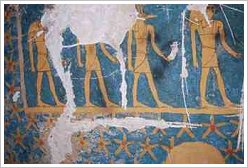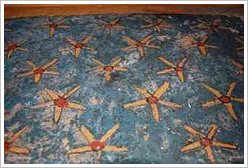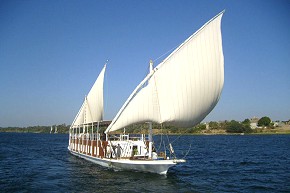We Provide
- Building Land
- Gabawi *1712 (350 sqm)
- Gorf *2105 (525 sqm)
- Gorf *2206 (700 sqm)
- Aqalta *2207 (1,050 sqm)
- House Building Service
- Architecture
- Real Estates
- Villa Hana, Ramla
- Shell Apartment Papyrus, Habu
- Apartment Hatshepsut 2, Gezira
- Apartment Hatshepsut 3, Gezira
- Apartment Hatshepsut 4, Gezira
- Holiday Flats
- Hatshepsut 1 (1 BR), Gezira
- Hatshepsut 2 (1 BR), Gezira
- Nile View (1 BR), Ramla
- Hatshepsut 3 (2 BR), Gezira
- Hatshepsut 4 (2 BR), Gezira
- Hatshepsut 5 (2 BR), Gezira
- Hatshepsut 7 (2 BR), Gezira
- Hatshepsut 9 (2 BR), Gezira
We Organise
We Report
- Sorry, no more news!
- News 2014 (26)
- News 2013 (76)
- News 2012 (92)
- December 2012 (4)
- November 2012 (12)
- October 2012 (7)
- September 2012 (12)
- August 2012 (4)
- July 2012 (2)
- June 2012 (7)
- May 2012 (4)
- April 2012 (11)
- March 2012 (10)
- Memnon Conference
- February 2012 (12)
- January 2012 (7)
- News 2011 (125)
- News 2010 (31)
- News 2009 (12)
- News Overview
Useful Tools
Dahabiya Nile Cruises• from Esna to Aswan |
Lake Nasser Cruises• from Aswan or Abu Simbel |
![]()
Living in Luxor - News in and around Luxor in September 2012
![]()
 When you mouse over a picture you will get a description and copyright information. Unless otherwise specified copyright is reserved by Living in Luxor. External links are marked with
When you mouse over a picture you will get a description and copyright information. Unless otherwise specified copyright is reserved by Living in Luxor. External links are marked with ![]() .
.
![]()
Performance to Celebrate World Tourism Day 2012, Luxor East Bank
(30/09/12)
World Tourism Day (WTD) established by UNWTO General Assembly is held annually on 27 September worldwide. Additionally, there is an official host. In 2011, celebrations took place in Aswan (Egypt), in 2012 in Maspalomas (Gran Canaria). 2012's theme was Tourism & Sustainable Energy: Powering Sustainable Development in order to highlight the steps taken so far by the international tourism community to power sustainable development with clean energy solutions.
After the official celebrations in front of the Karnak Temple on 27 September 2012, a performance of the Qena Group for Folk Dance took place at the Conference Center in Luxor yesterday night. The group's 50 participants - dancers, singers, and musicians - presented for one hour saidi music and folk dance with asayas (sticks), rababas (string instruments) and tanuras (skirts of the Egyptian whirling dervishes which should symbolise the sun disk). The mainly Egyptian audience was delighted.
In recent years, the Qena Group for Folk Dance joined festivals in many countries (Canada, Rwanda, Turkey, Azerbaijan, Oman, Jordan, Lybia, Sudan) and won three times in a row the first place at local festivals in Egypt.
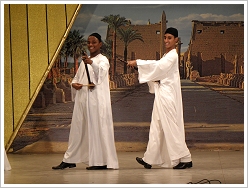 .
.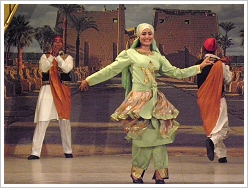
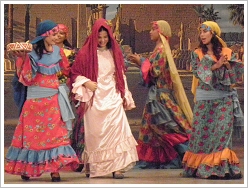
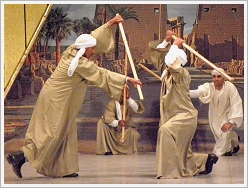
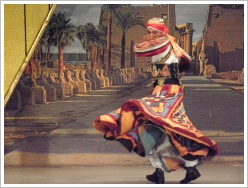
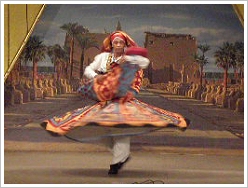
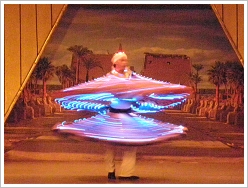
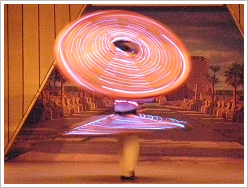
![]()
Luxor Culinary Challenge 2012
(26/09/12)
On 20/09/12 the Egyptian Chef's Association (ECA) called for the Luxor Culinary Challenge 2012. Kitchen teams from seven five-star hotels and four four-star hotels with all in all 40 chefs took part in the competition. At 10 a.m. the winners were announced. Every first prize recieved 1,000 LE. Here is the outcome:
- The best teams:
- 1st Place - Hilton Luxor
- 2nd Place - Maritime Jolie Ville Luxor
- 3rd Place - Sofitel Karnak
- The best chefs:
- 1st Place - Mubarak Mohamed Hashem, Sous Chef at the Sofitel Winter Palace Hotel Luxor
- 2nd Place - Ahmed Abdel Naby, 3rd Commis at the Maritime Jolie Ville Luxor
- 3rd Place - Ayman Tohamy, Demi Chef de Partie at the Steigenberger Nile Palace Luxor
The ECA jury was so impressed with one particular chef that they spontaneously created a new category for Best Competition Spirit: Abdel Rahman Saad, Chef de Partie at the Steigenberger Nile Palace Luxor was rewarded with 500 LE. The pasta competition was supposed to be with fresh home-made pasta in order to qualify. Only Abdel Rahman Saad followed the instructions - and gave the other chefs of his own pasta!

![]()
Cairo. Open City. New Testimonies from an Ongoing Revolution
(26/09/12)
Under this title an photo exhibition by Museum for Photography Braunschweig in collaboration with Braunschweig University of Art will open tomorrow 7 p.m.
![]() Cairo. Open City examines the roles that images are playing in the ongoing Egyptian revolution, from the outbreak of the Arab Spring through the
present. The exhibition will include a variety of approaches to the time-based media of photography and video, from the works of photo journalists, to
recordings by activists and "citizen journalists", to documents collected by different artists.
Cairo. Open City examines the roles that images are playing in the ongoing Egyptian revolution, from the outbreak of the Arab Spring through the
present. The exhibition will include a variety of approaches to the time-based media of photography and video, from the works of photo journalists, to
recordings by activists and "citizen journalists", to documents collected by different artists.![]()
On display will be photographs, videos, drawings and texts by prominent actors in the Cairo art scene as well as from young artists from Cairo, Nîmes and Braunschweig. The exhibition is open from 18/09/12 to 23/12/12.
![]() Exhibition venue: 267 . Quartiere für zeitgenössische Kunst und Fotografie,
Hamburger Straße 267, Braunschweig
Exhibition venue: 267 . Quartiere für zeitgenössische Kunst und Fotografie,
Hamburger Straße 267, Braunschweig

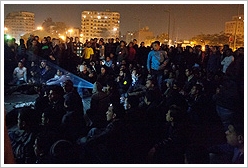
![]()
Re-Opening of the Serapeum at Saqqara
(22/09/12)
Since the inauguration on Thurday 20/09/12 the Serapeum and two tombs dating back to the Old Kingdom are open to the public.
A Serapeum was dedicated to the god Serapis, who combined aspects of Osiris and the bull-deity Apis. During its lifetime the sacred bull - there was only ever one Apis bull
at a time - was kept in aboveground stables. After its death it was embalmed and buried in the underground necropolis.
The Serapeum of Saqqara is located north west of the Pyramid of
Djoser at Saqqara. In 1851, while working for the Louvre in Paris the egyptologist Auguste Mariette noticed on a
visit to Saqqara a sphinx emerging from the sand. In the following years he excavated a row of sphinxes that led to the remains of two pylons and a temple. In turn, one of the chambers in the temple led to a vast
subterranean vault with 28 tomb niches and 25 empty granite sarcophagi.
In 1986, the Serpaeum has been closed to visitors because it was in danger of collapse. From 2001 to 2010 extensive restoration works have been done. Additionaly, a ventilation system has been installed. Now finally, the Apis
bull tombs have come back to Egypt’s tourist map.
Well, let's shift attention to the two opened noblemen tombs. One tomb is the wonderfully decorated and well-preserved tomb of Ptahhotep and his son Akhethotep. Both were viziers during the Fifth Dynasty. Ptahhotep is credited with authoring The Instruction of
Ptahhotep, an early piece of Egyptian wisdom literature (Elisabeth Haich picked it up in her book Initiation). The second tomb belongs to Mereruka, king Teti’s vizier and
chief justice minister during the Sixth Dynasty. It represents Saqqara's largest nobleman's tomb and bears excellent ancient Egyptian reliefs.
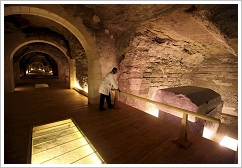
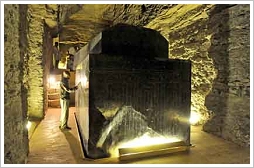
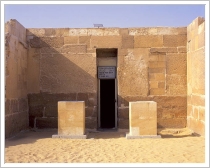
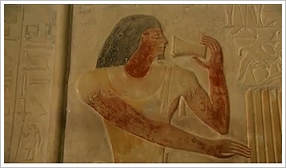
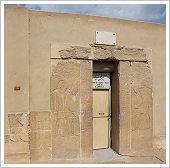
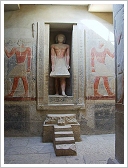
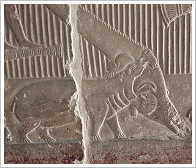
![]()
Egypt in the Guinness Book of Records
(22/10/12)
Egypt holds many world records: It has the world's tallest pyramid (the Great Pyramid at Giza was 146.7 m high when completed and has today 137.5 m in height) and the oldest pyramid (the Djoser Step Pyramid at Saqqara was constructed c. 2630 BC. It was the first cut-stone pyramid, too).
The oldest mummy comes from Egypt (the mummy of Wati, a court musician of c. 2400 BC from the tomb of Nefer in Saqqara). The first zoo was found at Hierakonpolis, south of Luxor with 112 creatures in total, including elephants, wildcats, baboons, hartebeests, and hippos dates back to 3500 BC, the first alphabet (it's not the earliest known "writing"!) to around 1900 BC (it was found carved into limestone in Wadi el-Hol near Luxor).
The oldest mine, a chert (silica) mine is Egyptian (first been in use around 100,000 years ago), the oldest horse stables, too (established by Pharaoh Ramses II in the ancient city of Piramesse. They are also believed to be the largest stables, covering approximately 17,000 m²).
The world's largest hypostyle (pillared) hall is - yes, you guess right - the hall of the Temple of Amun at Karnak with approximately 5,000 m². The Nile Valley and Delta is the most extensive oasis on Earth, covering approximately 22,000 km².
The first recorded assassination attempt was against Pharaoh Amenemhat I around 2000 BC. The first fully documented war, the Battle of Qadesh, was fought in approximately 1274 BC (Ramses II fought against the Hittites). It was also the largest battle by number of chariots (2,000 Egyptian, 3,000 Hittite). The running borderlands conflicts were finally concluded some fifteen years later by the first peace treaty (signed by Ramses II in 1271 BC). The first recorded strike in history took place on 14 November 1152 BC when the artisans of the Royal Necropolis at Deir el-Medina organised an uprising under the rule of Pharaoh Ramses III.
Nowadays set records are more related to physical performance: Egypt has the most wins of the football Africa Cup of Nations (1957, 1959, 1986, 1998, 2006, 2008 and 2010).
The most two finger push ups (one arm) in one minute is 46 by Mohammed Mohammed Ali Zeinhom (Egypt) in front of the Giza Pyramids in Cairo on 8 March 2010. The Egyptian bodybuilder Moustafa Ismail will appear in the 2013 edition of the Guinness Book of Records - with the world's biggest biceps (31 inch / 78,74 cm). The 24 year old lives in the United States since 2007, where he has “better access to gym equipment" (and steroids?).
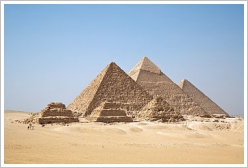

![]()
Debate on Egyptian Papyrus "Gospel of Jesus's Wife"
(20/09/12)
It's a tiny piece of papyrus the size of a business card that caused an internatiional sensation since its presentation Tuesday at an
international congress on Coptic studies in Rome. The 4th century text, written in Coptic and probably translated from a
2nd century Greek text, contains a dialogue in which Jesus refers to "my wife", whom he identifies as Mary and says "she will be able to be my disciple".
Even the Harvard researcher and expert for Coptology Karen King, who presented the papyrus, doesn't interprete these words as a proof that Jesus was married, "but it tells us that the whole question only
came up as part of vociferous debates about sexuality and marriage. From the very beginning, Christians disagreed about
whether it was better not to marry, but it was over a century after Jesus’ death before they began appealing to Jesus’ marital
status to support their positions”, she said.
However, the more exciting question is whether the papyrus is authentic or a modern
forgery. King got the fragment from an anonymous private collector who contacted King to help translate and
analyze it, in 2010. He provided her with a letter from the early 1980s indicating that a German professor for Egyptology from Berlin believed it to be evidence for a possible marriage of Jesus. The papyrus must have come from Egypt because only the early Egyptian Christians used Coptic as their language. Final conclusion about the
authenticity remains open to further examination and testing, especially of the
chemical composition of the ink.
Hany Sadak, the director general of the Coptic Museum in Cairo, said the fragment's existence was unknown
to Egypt's antiquities authorities until news articles this week. "I personally think, as a researcher, that the paper is not authentic because it was, if it had been in Egypt
before, we would have known of it and we would have heard of it before it left Egypt," he said.
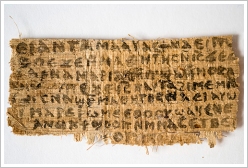
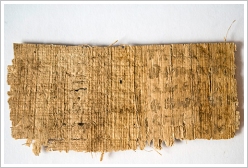
![]()
Opening of the 1st Luxor Egyptian and European Film Festival
(18/09/12)
Monday night, it was happening: Luxor's Culture Palace opened its doors for the 1st Luxor Egyptian and European Film Festival. Several hundreds of visitors had come to attend the official opening - more than the auditorium had seats.
At the beginning 3 female dancers of the Luxor Group for Folk Dance fascinated the audience with a mystical and aesthetic whirling dance in the tradition of the whirling dervishes of the Turkish Mevlevi Order.
After short words of thanks by the organisers, His Excellency Dr. Mohamed Saber Arab (the Egyptian Minister of Culture) and His Excellency Dr. Ezzat Saad (Governor of Luxor), the jury members who are responsible for the awarding of the 3 festival awards were presented.
The Egyptian actor Ahmed Helmy and the British producer Paul Webster were honored with the Djed Pillar Award, the latter for producing the film Salmon Fishing in the Yemen by Lasse Hallström. Amr Waked represents in this movie a wealthy Yemeni sheikh who has the vision to introduce salmon fishing to the desert country of Yemen. Waked himself presented the film that was screened afterwards. Incidentally, for the very first time not only the arabic productions had been subtitled in English but also all European films in Arabic!

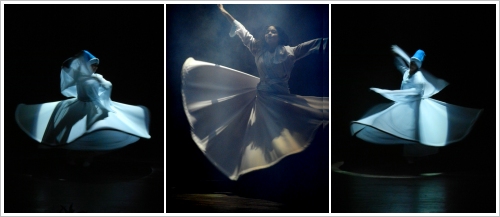
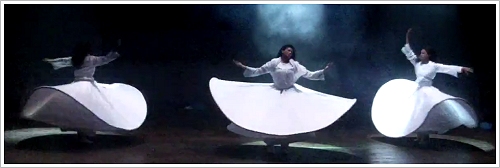
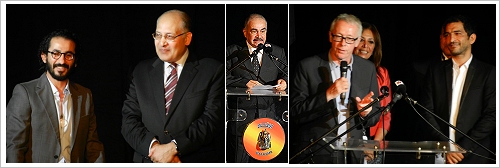
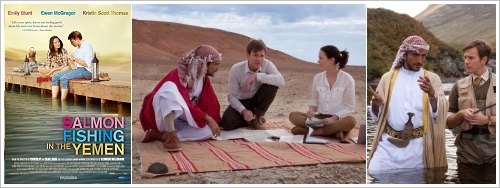
![]()
Film on Egyptian Revolution at 69th Venice International Film Festival
(12/09/12)
The Film Festival is part of the Venice Biennale and takes place every year in late August or early September. This year, the egyptian movie El Sheita Elli Fat ("Winter of discontent") competed for one of the highly coveted awards. Inspired by the spirit of the Egyptian revolution Egyptian director, Ibrahim El-Batout, began filming already during the revolution in Tahrir Square.
Amr Waked, best-known from "Fishing Salmon in the Yemen" which will be screened at the opening of the 1st Luxor Egyptian and European Film Festival, plays a political activist named Amr who was, because of his activities,
arrested and tortured by Mubarak's state security forces and now lives out of the world as a software designer. Farah, his former fiancée, is a news anchor on Egyptian television. She delivers the news minimizing the impact of the protests but her conscience starts weighing on her. Adel, a member of the state security forces, is responsible to arrest and interrogate many protesters. He was the officer assigned to interrogate Amr and also torture him. The film follows the lives of the three characters and let them find their way back to their values.
El Sheita Elli Fat didn't receive one of the awards but a very warm reception and a seven-minute long, standing ovation from the entire theatre at the end of its first showing. Here is the teaser:
![]()
Akhenaton's Religious Visions a Consequence of Epilepsy?
(07/09/12)
This is the opinion of Hutan Ashrafian from Imperial College London. He believes that an
heritable form of temporal lobe epilepsy in Akhenaton's family is responsible for hallucinations and religious
visions, for feminised figures and an early death. Already Thutmose IV, Akhenaton's grandfather, experienced a vision which was the reason for the erection of the so called Dream Stele between the two paws of the Great Sphinx at Giza. Akhenaton's visions encouraged him to raise
the status of the minor deity Aton into a supreme god. Thutmose IV, Amehotep III, Akhenaton and Tutankhamun were depicted with feminine features like unusually large breasts and wide hips. Ashrafian says that this can be explained with the fact that the temporal lobe is
connected to parts of the brain involved in the release of hormones, and epileptic
seizures are known to alter the levels of hormones involved in sexual development. However, the theory is almost impossible to
prove because there is no definitive genetic test for epilepsy. And egyptologists regard the feminine features just as a stylistic device of the Amarna period.
Source: Hutan Ashrafian: Familial epilepsy in the pharaohs of ancient Egypt's eighteenth dynasty, in: Epilepsy & Behavior, Volume 25, Issue 1, September 2012, Pages 23-31 (http://dx.doi.org/10.1016/j.yebeh.2012.06.014)
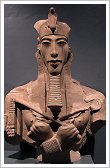
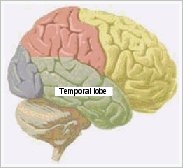
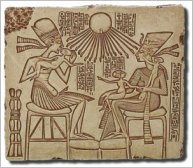
![]()
Long Nile Cruise from Cairo to Aswan on Board of a Dahabiya
(06/09/12)
Since 1994 Nile cruises were just allowed to operate between Cairo and Aswan. In November 2011, Egypt's tourism authority announced the resumption of the long Nile cruise, the full 14-day voyage all the way from Cairo to Aswan. In this autumn the route will be offered again for the first time.
It's particularly classy and relaxing to glide silently along the banks of the River Nile and enjoy the excellent food on board of a Dahabiya. Of course, sightseeing will not go short: the old city of Cairo, the Pyramids of Giza, Hawara, Meidum and Dahshur, the rock-cut tombs of Beni Hassan and Akhenaton's capital Amarna - to name but a few.
On 2 October 2012 the first Dahabiya of one of our business partners will start in Cairo. The sailing ship is a duplicate of one of the ancient sailing boats that already fascinated wealthy European travellers in the beginning of the 19th century. Do you want to be in on it? You may opt between the 15-day route from Cairo to Aswan and the 10-day route from Cairo to Luxor. Contact us for further details.
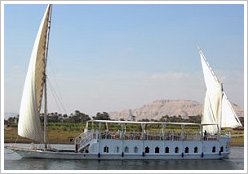
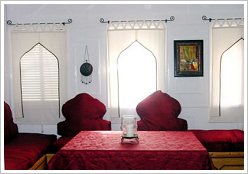
![]()
1st Luxor Egyptian and European Film Festival, Luxor East Bank
(10/09/12) Update: The programm for the Luxor Egyptian and European Film Festival is online now !
(06/09/12)
After the 1st Luxor African Film Festival in February 2012 the 1st Luxor Egyptian and European Film Festival will take place from 17 to 22 September 2012.
The festival will be opened with the British movie Salmon Fishing in the Yemen by Lasse Hallström and with the Egyptian actor Amr Waked. During the 5-day festival more than 70 films will be screened, among them films and short films with Luxor as a shooting location. British films will be another focus. You can see: Harry Potter and the Deathly Hallows Part II, Jane Eyre, Sherlock Homes and the Game of Shadows, The Iron Lady and The King's Speech. Until now, a schedule is not available.
Additionally, 10 new films from Egypt, Germany, Greece, Estonia, Portugal, Romania, Serbia, Finland, France and Spain will compete for three awards: the golden (15,000 $), silver (10,000 $) and bronze (15,000 $) Djed Pillar.
![]() Go to the Festival's Website
Go to the Festival's Website
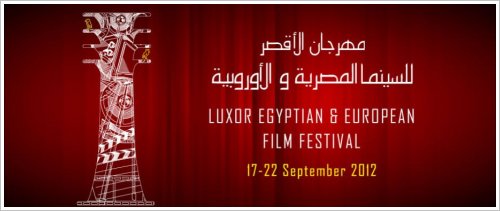
![]()
South Asasif Conservation Project Conference, Luxor East Bank
(05/09/12)
From 1 to 4 October 2012 a conference entitled "Thebes in the First Millenium BC" will take place in Luxor's Mummification Museum organised by the South Asasif Conservation Project
Team. The main focus is current archaeology and research
on tombs and temples of the 25th/26th dynasties
in the Theban area. The program contains presentations by renowned speakers as well as discussion panels and excursions.
![]() Preliminary conference programm (114 KB)
Preliminary conference programm (114 KB)
![]() Website with aAbstracts and registration form
Website with aAbstracts and registration form
